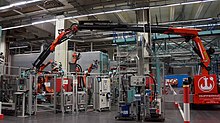Electric special assembly crane
The electric special assembly crane , also known as the indoor crane, is a special type of loading crane. Usually this is a loading crane that is mounted on a separate chassis. Both the chassis and the crane are operated electrically. Typical areas of application for such cranes are the indoor areas of various industries, in which low noise, zero emissions and flexibility in movement play an important role. These cranes can be roughly divided into two categories:
- In the majority of cranes, the loading crane is placed on an electrically operated chassis. They have been specially developed for working indoors and in confined spaces. They have special tires to protect the sometimes sensitive factory floor.
- In the indoor area of various industries such as the aircraft, food and car industries, however, cranes are required for special assemblies that have to meet significantly higher demands in terms of size and maneuverability. With these cranes, the loading crane is mounted on a highly flexible chassis.
The second category consists of cranes that can operate in the tightest of spaces with low noise, emission-free and remote control. This allows them to get to work areas that can otherwise only be reached by laborious dismantling . A typical example of this are the production lines in the automotive industry in which robots have to be replaced. This means that these cranes are a cost-effective alternative to expansion rails in the robot change concept. This minimizes downtimes. Various travel modes (e.g. diagonal, turning on the spot, all-wheel steering) enable precise maneuvering and movement.
Individual evidence
- ↑ Hüffermann's newest. Retrieved January 27, 2020 .
